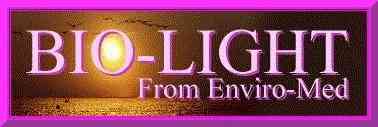 |
Enviro-Med 1600 S.E. 141st Ave. Vancouver, WA 98683 800-222-DAWN 800-222-3296 360-256-6989 |
|---|
| Contents: |
Light Therapy: A Cure for the Winter Blues
|
|---|---|
What Does SAD Feel Like?Brenda is a 37 year old woman who came to her internist in November complaining of extreme fatigue. She had difficulty waking up in the morning and found it increasingly more of an effort to get anything done. She had no energy, little interest in her friends and was irritable. She had gained 6 pounds and seemed drawn to sweets. Her work was not getting done, the house was not picked up and she felt more hopeless and depressed each day. Her history reflected similar problems each winter and she looked forward to spring when she became "her usual high energy self." What Causes the Symptoms and Who Gets Them?Brenda was suffering from Seasonal Affective Disorder (SAD), often referred to as winter depression. The disorder is brought on by the lack of bright light during the shortened days of winter. Sometimes called the hibernation response, the incidence of SAD increases with increasing latitude and is most prevalent in northern regions with their prolonged winter nights. An estimated 6% of the population suffers from full blown SAD. Another 14% experience a sub-clinical level of SAD resulting in the common winter doldrums. Women outnumber men 3 to 1 in reporting the disorder. Hormonal connections are being explored as the incidence of SAD increases after puberty and is reported less frequently by older women. It has also been associated with worsened PMS symptoms. The patient's tendency to overeat, oversleep, crave carbohydrates and experience weight gain are characteristic of SAD. These symptoms are considered atypical in contrast to the reduced sleep, poor appetite and weight loss associated with classic melancholic depression. Diagnosis is made on these "atypical" symptoms and the patient's history of reoccurring winter blues, remitting in the spring. Although researchers disagree on the exact cause, many theorize that there exists a lack of enough morning light to suppress the hormone melatonin. Studies show that blood levels of melatonin are immediately suppressed by exposure to bright light boxes. What Kind of Treatment is Available?Light therapy is the preferred choice of treatment because it is non-invasive and has a high success rate. Researchers recommend an ophthalmological and medication history to screen patients who have retinal problems or are taking photosensitizing agents. Those patients should receive an ophthalmological exam and be monitored closely or excluded from light therapy. Leading medical centers successfully treat sleep and mood disorders with light therapy including our own Oregon Health Science University. How are patients treated?
Light units should be designed to meet researchers specifications and be calibrated so the patient knows at what distance to sit in order to receive the proper lux level. Some insurance companies reimburse for the purchase of light boxes. The Diagnostic and Statistical Manual of the American Psychiatric Association lists the disorder as DSMIV-296.3X with "seasonal pattern," and this coding should be used in applying for insurance coverage. What are the Other Applications of Light Therapy?Light deprivation -- the primary cause of SAD -- is usually the result of the shorter days and longer nights of winter. But light deprivation may also be due to insufficient light exposure from indoor working conditions, health and age-related indoor confinement, shift work schedules, or unseasonably cloudy weather. Light therapy is an exciting, fast growing field. It is used to treat phase-advanced/phase-delayed sleep disorders, PMS, and age-related insomnia. In can be instrumental in helping people overcome jet lag and shift work schedule adjustments. Enviro-Med is a Washington based company providing consulting services, informational talks and research updates. Enviro-Med also designs and markets the BIO-LIGHT brand of light boxes used in clinics, research centers and homes. It's owner, Sherrie Baxter, is a SAD sufferer and user of light therapy. Enviro-Med, 800-222-3296, 360-256-6989, 1600 S.E. 141st Ave., Vancouver, WA 98683 Website: http://www.bio-light.com E-Mail: bio-light@bio-light.com |
|
Bio-Light Bright Light Therapy
Boxes |
[Contents] [Home] [Therapy] [Lights] [Order] [Articles] [About] [Feedback] [Site Map] DISCLAIMER: Enviro-Med cannot offer medical advice or recommend which individuals should receive light therapy for seasonal affective disorder, winter blues or other conditions. We advise that light therapy for seasonal affective disorder or other conditions be prescribed by a physician or other qualified health care professional and duration and timing supervised by the same. Consult with your physician to rule out any ophthalmological or other conditions that might preclude the use of light therapy. Copyright © 1997 Enviro-Med, www.bio-light.com
|
![[Picture of woman reading with Bio-Light]](images/ultwwomb_x100.jpg)